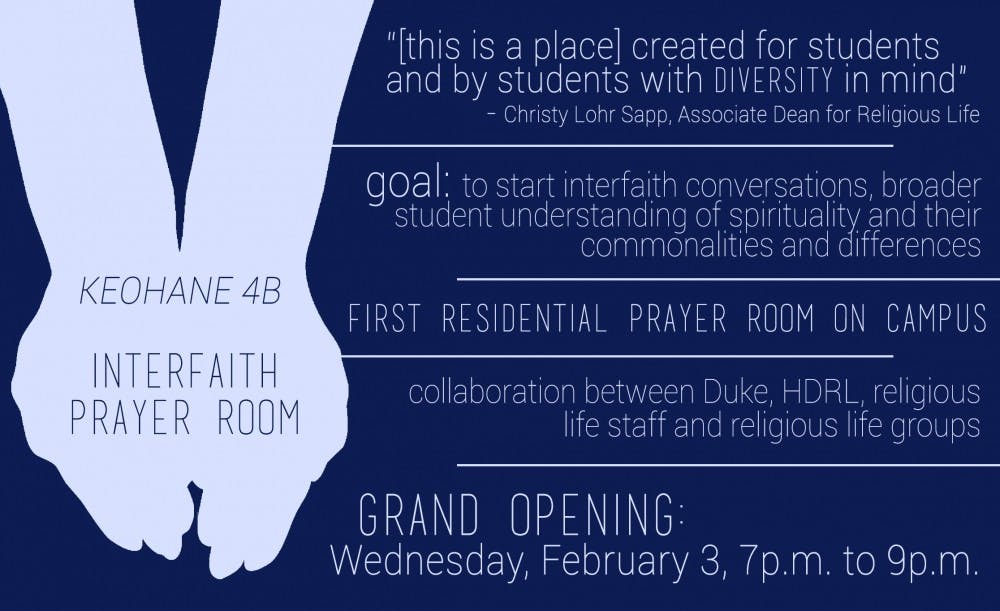An interfaith prayer room will open Wednesday in Keohane 4B for all undergraduate students.
The prayer room is a collaboration between Housing, Dining and Residence Life, religious life staff and religious groups on campus intended to create a sacred space available to students of any faith. Unlike the Muslim, Hindu, Buddhist and Divinity School prayer rooms, the new room will be located within a residence hall, instead of an academic building.
“This new prayer room is a step towards the direction of prioritizing people’s spiritual growth because it’s the first residential prayer room on this campus,” junior Meghana Rao said.
Jeff Nelson—residence coordinator for Keohane and a Divinity School graduate—had the initial idea for a residential, interfaith prayer room. When HDRL and the Office of Information Technology removed the computers from a computer lab in the dorm, Nelson said he decided to capitalize on the empty room.
Nelson and representatives from various religious groups on campus will host a grand opening for the room from 6 p.m. until 7 p.m. Wednesday. The ceremony will include a ribbon cutting and interfaith trivia, Nelson confirmed in an email Monday. The goal of the organizers is to have 60 people attend the opening, said Minoka Gunesekera, a second-year graduate student in the Divinity School.
Rao noted that she hopes students will become comfortable with the space by exploring it, beginning Wednesday night.
“Here we are in the middle of this dorm, and we’re going to make this room a place where people can go and sit in silence to contemplate and reflect and step outside of the stress and pressure,” she said.
In keeping with the room’s interfaith intentions, various books and religious materials have been donated by both the Durham community and people on campus. The room is equipped with benches, chairs, prayer mats and floor cushions. To respect different religions, the wall facing east has been left blank to allow Jewish students to pray toward Jerusalem without any barricades, the wall facing northeast has been left blank to allow Muslim students to pray toward Mecca and there is a space for students to remove their shoes before entering the room, as the removal of shoes is important in Islam, Hinduism and Buddhism.
The room is primarily for individual use instead of organized worship. However, both religious and nonreligious groups can reserve the space.
The room’s location gives it an advantage over other prayer spaces on campus, Gunesekera explained.
“Because it’s in a residence hall, it’s a little more accessible in the middle of the night or when some of the academic buildings might not be open,” she said.
Christy Lohr Sapp, associate dean for religious life, wrote in an email that she has often heard from students who want a place to pray at night when the Chapel is closed.
Gunesekera said she has also spoken to students who feel that campus can become “insular and barricading,” but said that this new space should offer a relief from the stressful environment.
“It is unique in that it’s not for studying and it’s not necessarily for purely social time,” Gunesekera said. “It’s almost like when you’re standing in that space, you don’t realize that you’re still on campus.”
Gunesekera added that she hopes to see interfaith conversations occur because of the room, allowing students to broaden their understanding of spirituality and recognize their commonalities or differences.
Rao said the room is primarily what the students make of it, but hope to see it remain a space “run by the students, for the students.”
“There’s an educational aspect to it because it really is about the coming together of people of different faiths and lack thereof,” Rao said. “It’s not a thing that is allocated only to those who believe in God or those who believe in many gods or those who don’t believe in a god.”
Lohr Sapp noted that the room represents a recognition of the diversity of religious life within the student body, especially because of the Christian chapel located in the middle of campus. She said it is also unique in that it allows students to pray on their own, without the leadership or assistance of religious life staff.
“It’s important to have this as a place for students first,” Lohr Sapp wrote. “Not as a place that is a public building or tourist attraction, but really created for students and by students with diversity in mind.”
Update: This article was updated Monday morning to modify the time of the grand opening, include the new information about the ceremony and clarify the walls that have been left blank.
Get The Chronicle straight to your inbox
Signup for our weekly newsletter. Cancel at any time.

